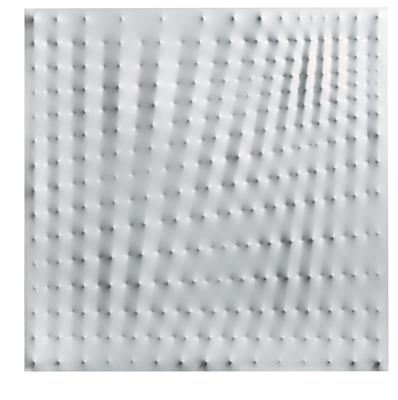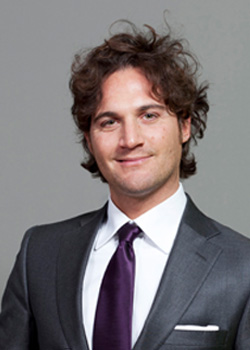Enrico Castellani *

(born in Castelmassa, Rovigo in 1930)
Superficie bianca, 1986, signed, titled and dated Enrico Castellani - Superficie Bianca - 1986, on the stretcher, acrylic on shaped canvas, 100 x 100 cm, framed, (AR)
Watch Video: Contemporary Art | November 2015 | Italian Contemporary Art
Photo certificate:
Archivio Castellani, Milan, archive no. 86–017
Provenance:
Lorenzelli Arte Milan (label on the reverse)
Ugo de Clemente Collection, Brescia
European Private Collection
Literature:
Renata Wirz, Federico Sardella (eds.), Enrico Castellani. Catologo ragionato, Opere 1955 – 2005, Skira, Geneva - Milan 2012, page 481, no. 600 with ill.
After the short yet significant experience of Azimuth, Enrico Castellani would for decades continue to experiment with the constant repetition of the same gesture, in keeping with a conception of artistic performance as analytical moment, of art as experience and of the work of art as “self-representing” object.
(Annamaria Maggi, Ricerca e ritmo, in Enrico Castellani, ed. by Marco Meneguzzo, exhibition catalogue, Galleria Fumagalli, Bergamo 1997).
A forerunner of Minimalism, Castellani makes his work unique and recognisable. Its analytical and craftsman origin could be traced back to Mondrian’s geometrical abstraction, Tatlin’s constructivism or the experiments of Bauhaus. Although he employs the traditional tools of a painter, he makes an utterly innovative use of them, for he places nails both on and under the canvas in order to create an alternating pattern and a contrast between introflected (concave) and extroflected (convex) points, between empty and full spaces, light and shadows. The passage from one nail to the next and the deflection of light within the interstices they create result in movement.
(Abo and Arturo Quintavalle, Castellani, University of Parma 1976)
In keeping with an idea of artistic work as craftsmanship and of creativity as concrete operative moment, Castellani brings the artwork from the abstract level of intuition back to the practical one of manual, repetitive, everyday work. This conception does not, however, prevent him from searching for the infinite by abolishing the limits of the canvas and commingling the space surrounding the potentially infinite gamut of his surfaces.
By limiting the compositional variations and by sticking to strict monochromy, Castellani creates works that aspire to the absolutely impersonal and do not demand to be read, interpreted or contemplated, but are simply what is visible to the eye, objects and subjects of creation.
“Monochromy is painting’s last chance to differentiate itself from the other forms of art; the surface that would previously be used in order to describe, refer to, or suggest something, that was once the stage of idylls, dramas and empty talks, is now mute. On painting’s last act the one coloured curtain fell and it would be hopeless to indulge in it with mystic contemplation.”
Expert: Alessandro Rizzi
 Alessandro Rizzi
Alessandro Rizzi
+39-02-303 52 41
alessandro.rizzi@dorotheum.it
25.11.2015 - 18:00
- Dosažená cena: **
-
EUR 417.800,-
- Odhadní cena:
-
EUR 220.000,- do EUR 340.000,-
Enrico Castellani *
(born in Castelmassa, Rovigo in 1930)
Superficie bianca, 1986, signed, titled and dated Enrico Castellani - Superficie Bianca - 1986, on the stretcher, acrylic on shaped canvas, 100 x 100 cm, framed, (AR)
Watch Video: Contemporary Art | November 2015 | Italian Contemporary Art
Photo certificate:
Archivio Castellani, Milan, archive no. 86–017
Provenance:
Lorenzelli Arte Milan (label on the reverse)
Ugo de Clemente Collection, Brescia
European Private Collection
Literature:
Renata Wirz, Federico Sardella (eds.), Enrico Castellani. Catologo ragionato, Opere 1955 – 2005, Skira, Geneva - Milan 2012, page 481, no. 600 with ill.
After the short yet significant experience of Azimuth, Enrico Castellani would for decades continue to experiment with the constant repetition of the same gesture, in keeping with a conception of artistic performance as analytical moment, of art as experience and of the work of art as “self-representing” object.
(Annamaria Maggi, Ricerca e ritmo, in Enrico Castellani, ed. by Marco Meneguzzo, exhibition catalogue, Galleria Fumagalli, Bergamo 1997).
A forerunner of Minimalism, Castellani makes his work unique and recognisable. Its analytical and craftsman origin could be traced back to Mondrian’s geometrical abstraction, Tatlin’s constructivism or the experiments of Bauhaus. Although he employs the traditional tools of a painter, he makes an utterly innovative use of them, for he places nails both on and under the canvas in order to create an alternating pattern and a contrast between introflected (concave) and extroflected (convex) points, between empty and full spaces, light and shadows. The passage from one nail to the next and the deflection of light within the interstices they create result in movement.
(Abo and Arturo Quintavalle, Castellani, University of Parma 1976)
In keeping with an idea of artistic work as craftsmanship and of creativity as concrete operative moment, Castellani brings the artwork from the abstract level of intuition back to the practical one of manual, repetitive, everyday work. This conception does not, however, prevent him from searching for the infinite by abolishing the limits of the canvas and commingling the space surrounding the potentially infinite gamut of his surfaces.
By limiting the compositional variations and by sticking to strict monochromy, Castellani creates works that aspire to the absolutely impersonal and do not demand to be read, interpreted or contemplated, but are simply what is visible to the eye, objects and subjects of creation.
“Monochromy is painting’s last chance to differentiate itself from the other forms of art; the surface that would previously be used in order to describe, refer to, or suggest something, that was once the stage of idylls, dramas and empty talks, is now mute. On painting’s last act the one coloured curtain fell and it would be hopeless to indulge in it with mystic contemplation.”
Expert: Alessandro Rizzi
 Alessandro Rizzi
Alessandro Rizzi
+39-02-303 52 41
alessandro.rizzi@dorotheum.it
|
Horká linka kupujících
Po-Pá: 10.00 - 17.00
kundendienst@dorotheum.at +43 1 515 60 200 |
| Aukce: | Současné umění |
| Typ aukce: | Salónní aukce |
| Datum: | 25.11.2015 - 18:00 |
| Místo konání aukce: | Wien | Palais Dorotheum |
| Prohlídka: | 14.11. - 25.11.2015 |
** Kupní cena vč. poplatku kupujícího a DPH
Není již možné podávat příkazy ke koupi přes internet. Aukce se právě připravuje resp. byla již uskutečněna.
Všechny objekty umělce
